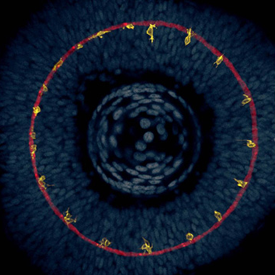Godinho Lab

We are interested in understanding how the vertebrate nervous system is assembled during development. We exploit the retina, an accessible part of the central nervous system, to probe the mechanisms that underlie the generation of diverse cell-types, their differentiation and finally their integration into synaptic circuits. With its compact, laminated structure, limited number of cell-types and well-characterized circuitry, the retina is particularly suited to studying nervous system assembly.
In mammalian species, retinal development largely occurs in utero, making the visualization of neurogenesis, differentiation and circuit integration difficult. We therefore use zebrafish, highly visual vertebrates that develop ex utero and are largely transparent during development, to study nervous system development in real time in vivo. By combining genetic tools and in vivo time-lapse imaging, we can follow the developmental trajectories of cells from the time of their ‘birth’ to their arrival at their definitive locations, and their integration into the local circuitry.
We are currently focusing our efforts on better understanding how retinal interneurons (horizontal cells, bipolar cells and amacrine cells) are generated. Our own past work and subsequent work of others has shown that the progenitor cells that generate some classes of retinal interneurons do not undergo mitotic divisions at the ventricular surface. Rather, these progenitors under mitosis in the very lamina in which the resulting interneurons will reside. We are probing whether such mitotic divisions are terminal or proliferative, symmetric or asymmetric and the underlying molecular signaling programs involved.